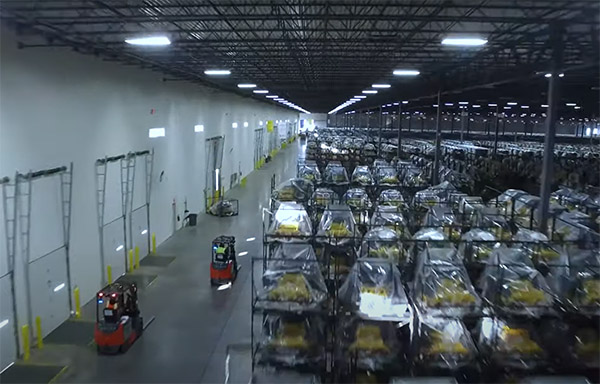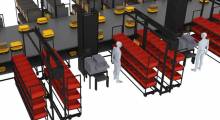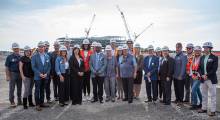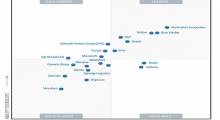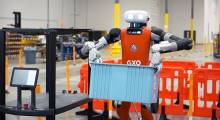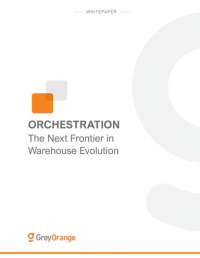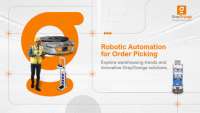Every link in the supply chain has been challenged to increase productivity. For every constraint of cost, workforce, or space, there is an opportunity for robots to speed fulfillment and boost efficiency. Wagner Logistics is looking at how its customers can maximize their use of existing facilities.
In January, Wagner Logistics expanded its own distribution center in Portland, Ore., but the third-party logistics provider (3PL) is looking at automation and micro-fulfillment centers (MFCs). The Kansas City, Mo.-based company finds and leases buildings across the U.S. where retailers can share space, labor, and equipment.
“We have 7 million sq. ft. of operations across 24 markets,” said Joe Oliaro, vice president of sales and chief real estate officer of Wagner Logistics. “We're heavy in the paper industry, automotive, and each picking for direct-to-consumer fulfillment.”
Oliaro has worked with Wagner Logistics for almost 14 years, and he explained to Robotics 24/7 how businesses need to rethink multi-use spaces, robotics, and customer demand to gain efficiency.
Demand for logistics robots still increasing
What are robots handling for your customers?
Oliaro: We worked with an arts-and-crafts group in Missouri. It had small items and wanted a way to bring costs down. It owned and ran a facility that was inefficient, and we showed how to take their projected volumes and apply automation to reduce labor costs.

The challenge in that market—in a small town—was that it was constantly churning labor. Any e-commerce fulfillment center has a ton of churn.
We came up with scissor lifts from inVia Robotics and designed the library. We have razor-thin margins as a 3PL, so we picked up shelving from a Home Depot and built a small library of 6,000 sq. ft. We were able to fit more than 2,000 SKUs.
The robots knew where things were and brought them to a pickwall. We took laborers who picked 25 picks an hour to 300 picks an hour. Since then, we've taken a more traditional Wagner approach to getting pallets in and out of our warehouses.
How much awareness and demand is there for automation?
Oliaro: We're getting a lot of requests to consider automation in RFPs [requests for proposals] and in conversations with existing customers. We're also talking with Outrider, GreyOrange, and others that provide AGVs.
Customers ask about an automation roadmap: “How do we get this under way?” and “Where do we start?” They're asking us for help—“We could do it tomorrow, but it's expensive.”
At the same time, so is labor and transportation to wherever the warehouse is located. The declining costs of robotics is finding that meeting point.
We're finding all the long-distance or repetitive moves in the warehouse and automating those first. We're putting together a three-year ramp up to full automation.
Evaluating automation, micro-fulfillment, and ASRS
What does Wagner Logistics look for in robots?
Oliaro: We look for the right fit. We've had to be diligent about the different users we go after. The main theme that comes up when we evaluate robotics providers is whether or not they're legit.
Some have beautiful websites, but their technologies are not implemented anywhere. It makes it more difficult for us to instill confidence if our system has never been tested.
We're not taking big risks. Our customers are typically Fortune 500 companies with over $100 million in revenue. They don't want to take those risks to their bottom lines.
How does micro-fulfillment change how you think about space and use it?
Oliaro: We’ve had interaction with Brookfield, a real estate investment trust [REIT] that focuses on shopping mall properties that can be turned into MFCs. What's interesting is the shift in retail from expensive space, in terms of revenue per square foot.
Stores can't keep as much product in the back room as before, but with more data, they can reduce the amount of products on hand. For example, a retailer may know that consumers prefer to buy Size 7 loafers online, but they'll want to feel the latest Jordans in person. It's more experience-based.
Without keeping everything on hand, they rely on larger distribution centers or outsourced fulfillment. It's a natural next step to take an unused lot or an old Sears Auto Center.
How do MFCs compare with automated storage and retrieval systems (ASRS)?
Oliaro: We've looked at very narrow aisle [VNA] systems and pallet-shuttling systems within racks and showed a customer how it could reduce its footprint. Such systems could have facilitated 60% less footprint than it was planning for, but it had already signed a lease.
Dense storage is coming. Pallet shuttling very interesting because it can create multiple efficiencies. We're seeing that companies doing that kind of work have products with high retail margins and volume to make longer-term investments worthwhile.
Understand demand, when to automate
Is there a difference in e-commerce versus retail or omnichannel demand?
Oliaro: For instance, toilet paper is a commoditized product. People don't care if they go to a store to find it.
But increasingly, there's a barbell effect of commoditized products versus a boutique experience, but nowhere in the middle. U.S. consumers have started to approach their buying accordingly.
When is automation not the best option?
Oliaro: In the paper industry, large rollstacks. Electric lifts can be automated, but they're not sizeable enough to move heavy rolls. You need a propane lift with a clamp to lift and move them and move them to a staging area.
AGVs can come in—they look like a large pallet jack—and take rolls to the printing presses, but we have yet to come up with something that can replace a propane forklift without substantial expenses.
There are other tasks that are hard to automate, like kitting—taking items from multiple shelves and putting them into a kit. Long-distance travel can also be hard to fully automate.
Wagner Logistics looks to ride out disruptions
How concerned are you about further supply chain disruptions, such as from a recession?
Oliaro: Economists have been talking about it for a while, but I don't think it's a long-term concern.
A lot of manufacturing has been reshoring because of trade restrictions with China. We're expecting $1 trillion in business to come back to the U.S., which bodes well for 3PLs and service providers here.
The real challenge is continued low vacancy rates in most major markets around the U.S. We're finalizing a facility in Portland with sub-3% vacancy.
If you look at the Inland Empire [in Southeastern California], there's no space at all. Businesses have been waiting in line for months for a building to come up, and then they're paying insane amounts.
Wagner is looking at tertiary markets where there's a little more vacancy and decent labor outside the top 50 markets.
How does this affect the use of backroom space?
Oliaro: It's a common theme among retailers and warehouses. The trend up to the [COVID-19] pandemic was just-in-time inventory and to store as little as possible. The assumption was that manufacturers could pump out products and get them to customers as fast as possible.
When the pandemic hit, not only were manufacturers struggling to ramp up to meet demand, but they needed overflow space. It changed customer behavior, and they had to pay a bunch more for warehouse space.
Does this mean that good data visibility and analytics are as valuable as space?
Oliaro: Most of the customers we work with don’t do a good job of managing inventory or predicting needs.
By sharing costs in a multi-customer facility, Wagner can be subject-matter experts, giving them flexibility and helping to anticipate what they need. We can show them metrics and help them make better business decisions.
We're planning site visits where automation across tenants will be on display.
About the Author
Follow Robotics 24/7 on Linkedin
Article topics
Email Sign Up

